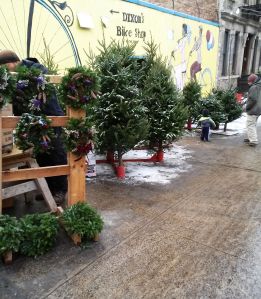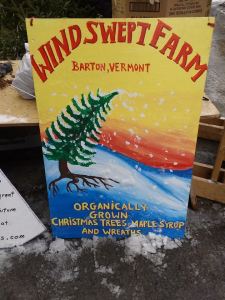I have mixed feelings everytime I pass Christmas Tree vendors. On one hand, I love the Earthy smell of pine and the beautiful flourish of evergreen colors filling my vision. On the other hand, I look at the tree trunks cut off abruptly before the roots and feel a little sad for the trees, once deeply rooted, majestic and bursting with life, that are now destined to wither away after a few festive weeks of viewing pleasure. But don’t let me put a damper on your holiday spirit. I know decorating and enjoying a Christmas Tree can be a beautiful experience. That said, there are green options for everyone, even people like me who would prefer a potted tree.
Plastic versus Real Trees: which is better for the environment and healthier for you?
I would vote, hands down, for real trees for multiple reasons:
- Plastic trees are made from petroleum. Oil drilling is very risky for the environment (think oil spills). Oil is a non-renewable resource. And, once your plastic Christmas tree becomes old and ratty, it is destined for a landfill and will not bio-degrade. Plus, landfill space is finite. Do we really need to create more garbage than is necessary? However, if you already have a artificial tree, enjoy it while it lasts. If it is still usable when you are done with it, find a local charity donate it to. There may also be recycling possibilities available in your area. Please know, however, that each time plastic is recycled, it downgrades in quality, until it is un-recyclable and ends up in the landfill anyway.
- Real trees do not have to go to a landfill (in a landfill they would take a VERY long time to biodegrade). Personally, if I had a few acres of wooded land, I would just let my Christmas tree become food for microorganisms. However, for many urbanites like myself, “treeycling” would be the best option. According to Earth911, “Recycled trees are most commonly used for mulch, erosion protection, habitat creation and shoreline stabilization.” To find out if tree reycling resources are in your area, go to: http://earth911.com/news/2011/12/27/how-to-recycle-your-christmas-tree/
- Several known carcinogens, including dioxin, ethylene dichloride and vinyl chloride, are generated during the production of PVC (a major component of artificial Christmas trees), polluting neighborhoods and ecosystems located near factory sites. Most of those factory sites are actually in China, where 85 percent of the artificial trees sold in North America are made. Labor standards in China do not adequately protect workers from the dangerous chemicals they are handling. Not to mention, fake trees often contain lead.
- Real trees are more pleasurable to look at and also emit phytoncides (wood essential oils) which are beneficial to our health on many levels (think aromatherapy). More information is available in the book, “Your Brain On Nature”.
- According to Earth911, “A single farmed tree absorbs more than 1 ton of CO2 throughout its lifetime. With more than 350 million real Christmas tress growing in U.S. tree farms alone, you can imagine the yearly amount of carbon sequestering associated with the trees. Additionally, each acre of trees produces enough oxygen for the daily needs of 18 people.”
- My initial concern about Christmas tree farms was that it could mean the destruction of ecosystems, particularly, if forests were cleared so Christmas trees could be grown. However, according to the New York Times, “Christmas tree farms also help preserve farmland and green space, particularly near densely populated urban areas where pressure for development is intense.” Additionally, Mike Garrett, owner and operator of a Christmas tree farm in Sussex, N.J. said, “It allows people with land that may not be the best farmland to have a crop that they can actually make a profit on, and not be under pressure to sell out to developers.”
- One of the downsides, many green-tip websites are quick to point out, is the carbon footprint from driving to get a real Christmas tree every year, as opposed to once every 10 years for a fake tree. But really, is one extra errand a year going to make or break your carbon footprint? And, what if, you ran some other errands along the way to your Christmas tree-shopping, making it a very efficient trip? I think it’s more about all of us investing in greener transportation modes (the greenest we are able to afford) that reduce our overall impact or are carbon neutral, which has a much larger positive impact, than one less errand.
- Another downside is that many Christmas tree farms use pesticides and artificial fertilizers, which are not good for surrounding eco-systems, nor for your health. However, depending on where you live, you may be able to purchase an organically raised Christmas tree. Here are some green resources websites that can help you in your search for a sustainable Christmas tree or any other sustainable products your heart could desire:
Here is a (somewhat) local Christmas tree farm serving the NYC area:
Buying a Living Tree
If you want to go uber green or cut trees just make you a little sad, opt to buy a Christmas tree with its roots still intact. Keep in mind, however, that a living tree can only be indoors for about a week, lest it “wake up” and begin to grow again in the warmth of your home. If this happens there is a good chance the tree will not survive once it is replanted in the cold winter outdoors. You would also need to gently transition the tree indoors for about two weeks beforehand, inside a garage or enclosed porch. You would need to put the tree back in the enclosed porch or garage after its week indoors to gently transition it back outside. For more information on buying and caring for a living tree, go to:
http://www.hgtv.com/gardening/how-to-care-for-your-living-christmas-tree/index.html
A few online articles also mentioned keeping the tree in a pot for a few years so it can be reused as a Christmas tree again. I assume that they mean a smaller potted Christmas trees that wouldn’t quickly outgrow the ability to fit indoors. I also assume that the tree would live outdoors in a pot when it is not the holiday season:
http://eartheasy.com/give_sustainchristmas.htm
Last, but not least, I am teleported back to childhood, when we had our first “Christmas tree”. Well, it was not really a Christmas tree in the traditional sense; it was my mom’s potted Norfolk Pine houseplant that was suddenly transformed into an exotic, four foot Christmas marvel. Needless to say, Peanutbutter, our fluffy tan and white cat, could not resist climbing the Norfolk Pine, which bowed under his robust weight, to retrieve Christmas ornaments dangling off it. We later found the said ornaments floating and sparkling in the toilet. On that note, may your holiday be warm, wonderful, magical and perhaps, even a little bit playfully mischievous!



We got my parents a live tree last year, they had lost a dozen trees to Sandy, so they were happy to have one they could plant after Xmas.
I’m so sorry that I never replied to this. I like that you got your parents a live tree that also benefited their property. It’s funny to write about this in June, but what the heck 😉